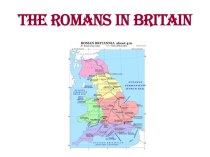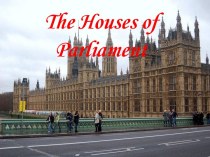- Главная
- Разное
- Бизнес и предпринимательство
- Образование
- Развлечения
- Государство
- Спорт
- Графика
- Культурология
- Еда и кулинария
- Лингвистика
- Религиоведение
- Черчение
- Физкультура
- ИЗО
- Психология
- Социология
- Английский язык
- Астрономия
- Алгебра
- Биология
- География
- Геометрия
- Детские презентации
- Информатика
- История
- Литература
- Маркетинг
- Математика
- Медицина
- Менеджмент
- Музыка
- МХК
- Немецкий язык
- ОБЖ
- Обществознание
- Окружающий мир
- Педагогика
- Русский язык
- Технология
- Физика
- Философия
- Химия
- Шаблоны, картинки для презентаций
- Экология
- Экономика
- Юриспруденция
Что такое findslide.org?
FindSlide.org - это сайт презентаций, докладов, шаблонов в формате PowerPoint.
Обратная связь
Email: Нажмите что бы посмотреть
Презентация на тему Welcome to London
Содержание
- 3. We are now in Trafalgar Square. From here we start our tour!
- 4. It is a map of London! We are here!
- 5. And now, we'll see a description of this attraction
- 6. St. Paul`s Cathedral
- 7. The Tower of London!
- 8. Tower of London!
- 9. Westminster Abbey!
- 10. Royal Albert Hall
- 11. Victoria & Albert Museum
- 12. Buckingham Palace
- 13. Saint James`s Park
- 14. The British Museum
- 15. Madam Tussaud`s Museum
- 16. Madam Tussaud`s Museum
- 17. Madam Tussaud`s MuseumThe National Gallery
- 18. THE END
- 19. TRAFALGAR SQUAREA square in central London where
- 20. Saints Paul`s CathedralSt Paul's is London's cathedral
- 21. The Tower of LondonThe Tower of London
- 22. Westminster AbbyWestminster Abbey is steeped in more
- 23. Royal Albert HallSince its opening by Queen
- 24. VICTORIA & ALBERT MUSEUMThe Victoria and Albert
- 25. Buckingham Palace and Queen Victoria MemorialThe Victoria
- 26. SAINT JAMES`S PARKIn 1532, Henry VIII purchased
- 27. The British MuseumThe British Museum, in London,
- 28. Скачать презентацию
- 29. Похожие презентации
We are now in Trafalgar Square. From here we start our tour!







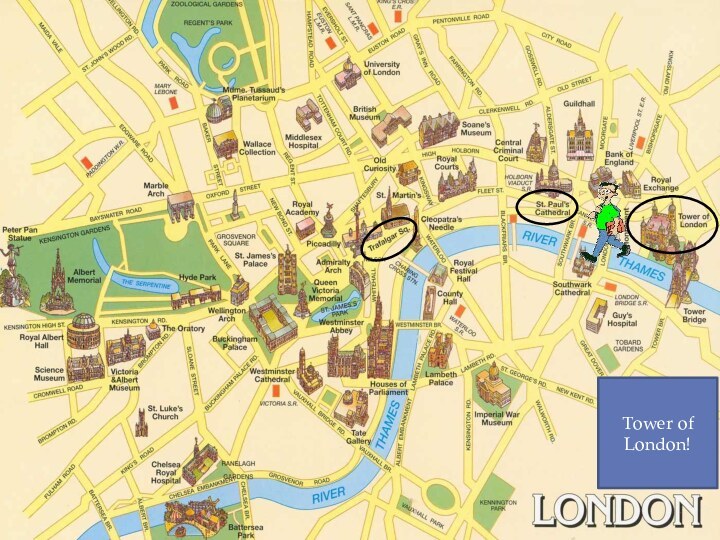







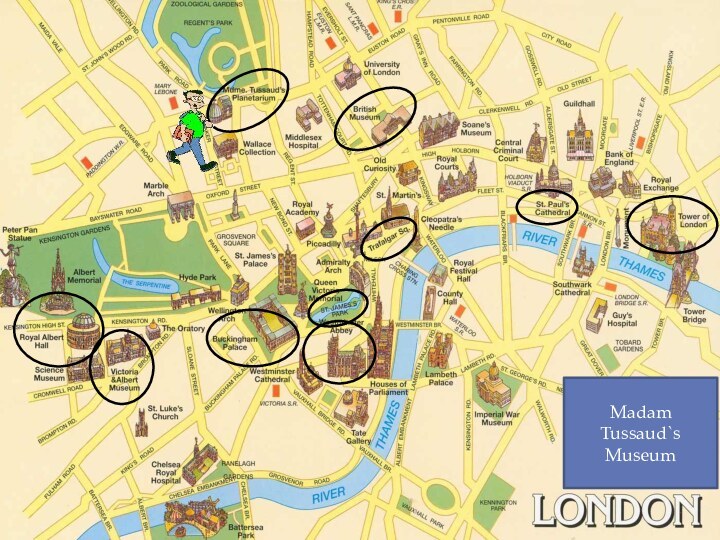











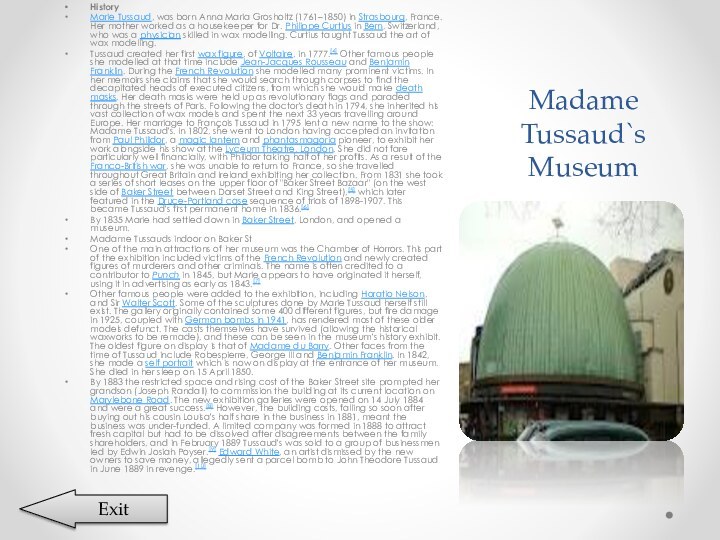
Слайд 19
TRAFALGAR SQUARE
A square in central London where Pall
Mall, the Strand, and Charing Cross Road meet. Trafalgar
Square is where Nelson`s Column stands, and is also known for the large numbers of pigeons which come there and are fed by tourists. There are a number of famous buildings and monuments in the square, including the National Gallery and St Martin-un-the-Fields. Trafalgar Square is also popular meeting place for political and other demonstrations (named in commemoration of Nelson`s victory at the Battle of Trafalgar)Back
Слайд 20
Saints Paul`s Cathedral
St Paul's is London's cathedral and
embodies the spiritual life and heritage of the British
people. Cathedrals serve a wide community. A cathedral houses the seat - or in Latin, cathedra - of the bishop, making it a center for Christian worship and teaching, and the Christian mission.St Paul's Cathedral acts as an important meeting place for people and ideas, as a center for the arts, learning and public debate.
St Paul’s is the cathedral of the Diocese of London. The Diocese is made up of five episcopal areas: Willesden, Edmonton, Stepney, London and Kensington. Four of these have an Area Bishop, to whom the Bishop of London, The Right Reverend and Right Honorable Richard Chartres, delegates certain responsibilities. The Bishops are assisted by Archdeacons. Archdeaconries are further divided into deaneries which are groups of parishes.
Back
Слайд 21
The Tower of London
The Tower of London is
the fortress in the historic center of London, on
the north bank of the river Thames. It is the oldest building in Great Britain. Now Tower is the historical site and museum.The founder of Tower was William the Conqueror, who replaced the wooden fort onto huge stone building in 1078. Later the Tower was whitewashed and since it called as White Tower. The White Tower is 90 feet high and the walls vary from 15 feet thick at the base to almost 11 feet in the upper parts. In the 1190s, King Richard the Lion heart enclosed the White Tower with a curtain wall, and had a moat around it filled with water from the Thames. In the early thirteenth century Henry III transformed the Tower into a major royal residence and had palatial buildings constructed within the Inner Bailey to the south of the White Tower. In 1240 Henry III had the exterior of the building whitewashed. Between 1275 and 1285 Edward I built an outer curtain wall, completely enclosing the inner wall and thus creating a concentric double defense.
The first prisoner was confined in the prison in 1190. At that time the Tower-prison was intended for noble and high rank persons. Among the most honorable and high-ranking prisoners there was the kings of Scotland and France and members of their families, and aristocrats and priests, who fell into disgrace by reason of conspiracy charge. Many executions and killings took place inside of Tower walls: Henry VI, twelve-year-old Edward V and his younger brother, Anne Boleyn, Catherine Howard, Lady Jane Grey. Elisabeth I had spent in Tower several troubled weeks.
The Tower remained a royal residence until the time of Oliver Cromwell, who destroyed some of the old palatial buildings. After that the Tower prison was replenished seldom. The last beheading took place on Tower Hill in 1747. In time of the First World War the eleven German spies was confined in Tower and executed by shooting. In time of the Second World War prisoners of war was temporarily appeared there. The last victim was Josef Jacobs, charged in German espionage and executed inside the Tower walls on 14 August 1941.
Back
Слайд 22
Westminster Abby
Westminster Abbey is steeped in more than
a thousand years of history. Benedictine monks first came
to this site in the middle of the tenth century, establishing a tradition of daily worship which continues to this day.The Abbey has been the coronation church since 1066 and is the final resting place of seventeen monarchs.
The present church, begun by Henry III in 1245, is one of the most important Gothic buildings in the country, with the medieval shrine of an Anglo-Saxon saint still at its heart.
A treasure house of paintings, stained glass, pavements, textiles and other artifacts, Westminster Abbey is also the place where some of the most significant people in the nation's history are buried or commemorated. Taken as a whole the tombs and memorials comprise the most significant single collection of monumental sculpture anywhere in the United Kingdom.
The Library and Monument Room houses the important (and growing) collections of archives, printed books and manuscripts belonging to the Dean and Chapter of Westminster, providing a center for their study and for research into all aspects of the Abbey's long and varied history.
Back
Слайд 23
Royal Albert Hall
Since its opening by Queen Victoria
in 1871, the world's leading artists from several performance
genres have appeared on its stage and it has become one of the UK's most treasured and distinctive buildings. Each year it hosts more than 350 events including classical concerts, rock and pop, ballet and opera, sports, award ceremonies, school and community events, charity performances and banquets.The hall was originally supposed to have been called The Central Hall of Arts and Sciences, but the name was changed by Queen Victoria to Royal Albert Hall of Arts and Sciences when laying the foundation stone as a dedication to her deceased husband and consort Prince Albert. It forms the practical part of a national memorial to the Prince Consort – the decorative part is the Albert Memorial directly to the north in Kensington Gardens, now separated from the Hall by the road Kensington Gore.
Back
Слайд 24
VICTORIA & ALBERT MUSEUM
The Victoria and Albert Museum
(often abbreviated as the V&A), is the world's largest
museum of decorative arts and design, housing a permanent collection of over 4.5 million objects. Named after Prince Albert and Queen Victoria, it was founded in 1852, and has since grown to cover 12.5 acres (51,000 m2)[2] and 145 galleries. Its collection spans 5,000 years of art, from ancient times to the present day, in virtually every medium, from the cultures of Europe, North America, Asia and North Africa. The museum is a non-departmental public body sponsored by the Department for Culture, Media and Sport.The holdings of ceramics, glass, textiles, costumes, silver, ironwork, jeweler, furniture, medieval objects, sculpture, prints and printmaking, drawings and photographs are among the largest, important and most comprehensive in the world. The museum possesses the world's largest collection of post-classical sculpture, the holdings of Italian Renaissance items are the largest outside Italy. The departments of Asia include art from South Asia, China, Japan, Korea and the Islamic world. The East Asian collections are among the best in Europe, with particular strengths in ceramics and metalwork, while the Islamic collection, alongside the British Museum, Muse du Louvre and Metropolitan Museum of Art, New York City, is amongst the largest in the Western world.
Set in the Brampton district of the Royal Borough of Kensington and Chelsea, neighboring institutions include the Natural History Museum and Science Museum, the V&A is located in what is termed London's "Albert polis", an area of immense cultural, scientific and educational importance. Since 2001, the museum has embarked on a major £150m renovation programmed,[3] which has seen a major overhaul of the departments, including the introduction of newer galleries, gardens, shops and visitor facilities. Following in similar vein to other national British museums, entrance to the museum has been free since 2001.
Back
Слайд 25
Buckingham Palace and Queen Victoria Memorial
The Victoria Memorial
is a sculpture in London, placed at the center
of Queen's Gardens in front of Buckingham Palace and dedicated to Queen Victoria.The Memorial was dedicated in 1911 by George V and his first cousin, Wilhelm II of Germany, the two senior grandsons of Victoria. The sculptor was Sir Thomas Brock. It was completed with the installation of the final bronze statues in 1924.
The surround was constructed by the architect Sir Aston Webb, from 2,300 tons of white marble. It is a Grade I listed building.
It has a large statue of Queen Victoria facing north-eastwards towards The Mall. The other sides of the monument feature dark paginated bronze statues of the Angel of Justice (facing north-westwards toward Green Park), the Angel of Truth (facing south-eastwards) and Charity facing Buckingham Palace. On the pinnacle is a statue of unclear entitlement and arguably relating both to 'Peace' and to 'Victory', with two seated figures (the subsidiary figures were given by the people of New Zealand).
The whole sculptural programmed has a nautical theme, much like the rest of the mall (Admiralty Arch etc.). This can be seen in the mermaids, mermen and a hippogriff, all of which are suggestive of the United Kingdom's naval power.
There is a similar memorial to her husband, Albert, the Prince Consort outside the Royal Albert Hall.
Buckingham Palace, in London, is the official residence and office of the British monarch.[1] Located in the City of Westminster, the palace is a setting for state occasions and royal hospitality. It has been a focus for the British people at times of national rejoicing and crisis.
Originally known as Buckingham House, the building which forms the core of today's palace was a large townhouse built for the Duke of Buckingham in 1705 on a site which had been in private ownership for at least 150 years. It was subsequently acquired by George III in 1761[2] as a private residence for Queen Charlotte, and known as "The Queen's House". During the 19th century it was enlarged, principally by architects John Nash and Edward Blore, forming three wings around a central courtyard. Buckingham Palace finally became the official royal palace of the British monarch on the accession of Queen Victoria in 1837. The last major structural additions were made in the late 19th and early 20th centuries, including the East front which contains the well-known balcony on which the Royal Family traditionally congregate to greet crowds outside. However, the palace chapel was destroyed by a German bomb in World War II; the Queen's Gallery was built on the site and opened to the public in 1962 to exhibit works of art from the Royal Collection.
The original early 19th-century interior designs, many of which still survive, included widespread use of brightly coloured scagliola and blue and pink lapis, on the advice of Sir Charles Long. King Edward VII oversaw a partial redecoration in a Belle Époque cream and gold colour scheme. Many smaller reception rooms are furnished in the Chinese regency style with furniture and fittings brought from the Royal Pavilion at Brighton and from Carlton House. The Buckingham Palace Garden is the largest private garden in London.
The state rooms, used for official and state entertaining, are open to the public each year for most of August and September, as part of the Palace's Summer Opening
Back
Слайд 26
SAINT JAMES`S PARK
In 1532, Henry VIII purchased from
Eton College an area of marshland, through which the
Tyburn flowed. This land lay to the West of York Place, recently acquired by Henry from Cardinal Wolsey; it was purchased in order to turn York Palace into a dwelling fit for a king. On James I's accession to the throne in 1603, he ordered that the park be drained and landscaped, and kept exotic animals in the park, including camels, crocodiles, and an elephant, as well as aviaries of exotic birds along the south.During Charles II's exile in France under the Commonwealth of England, the young king was impressed by the elaborate gardens at French royal palaces, and on his ascension had the park redesigned in a more formal style, probably by the French landscaper André Mollet. This included the creation of the 775 by 38 metre (850 by 42 yard) canal visible in the old plan. Charles II opened the park to the public, as well as using the area to entertain guests and mistresses, such as Nell Gwyn. The park was notorious at the time as a meeting place for acts of degeneracy, of which John Wilmot, 2nd Earl of Rochester wrote in his poem A Ramble in St. James's Park.
In the late 17th and early 18th century cows were grazed on the park, and milk could be bought fresh at the "Lactarian", described by Zacharias Conrad von Uffenbach in 1710.[3]
The 18th century saw further changes, including the reclamation of part of the canal for Horse Guards Parade and the 1761 purchase of Buckingham House (now Buckingham Palace) at the west end of the Mall, for the use of Queen Charlotte.
Further remodelling in 1826–7, commissioned by the Prince Regent (later George IV) and overseen by the architect and landscaper John Nash, saw the straight canal's conversion to a more naturally-shaped lake, and formal avenues rerouted to romantic winding pathways. At the same time, Buckingham House was expanded to create the current palace and Marble Arch was built at its entrance, whilst The Mall was turned into a grand processional route, opened to public traffic 60 years later in 1887, the Marble Arch having been moved to its current location at the junction of Oxford Street and Park Lane in 1851 and replaced with the Victoria Memorial between 1906 and 1924.
Back
Слайд 27
The British Museum
The British Museum, in London, is
widely considered to be one of the world's greatest
museums of human history and culture. Its permanent collection, numbering some eight million works,[2] is amongst the finest, most comprehensive, and largest in existence[2] and originate from all continents, illustrating and documenting the story of human culture from its beginnings to the present.[a]The British Museum was established in 1753, largely based on the collections of the physician and scientist Sir Hans Sloane. The museum first opened to the public on 15 January 1759 in Montagu House in Bloomsbury, on the site of the current museum building. Its expansion over the following two and a half centuries was largely a result of an expanding British colonial footprint and has resulted in the creation of several branch institutions, the first being the British Museum (Natural History) in South Kensington in 1887. Some objects in the collection, most notably the Elgin Marbles from the Parthenon, are the objects of intense controversy and of calls for restitution to their countries of origin.
Until 1997, when the British Library (previously centered on the Round Reading Room) moved to a new site, the British Museum was unique in that it housed both a national museum of antiquities and a national library in the same building. The museum is a non-departmental public body sponsored by the Department for Culture, Media and Sport, and as with all other national museums in the United Kingdom it charges no admission fee.[3] Since 2002 the director of the museum has been Neil MacGregor.[4]
Back



















